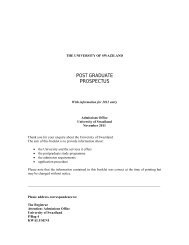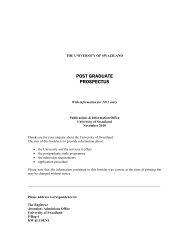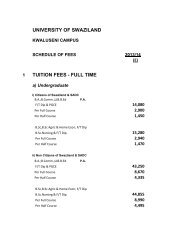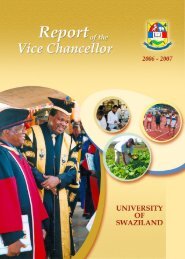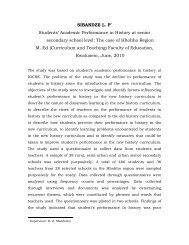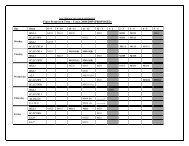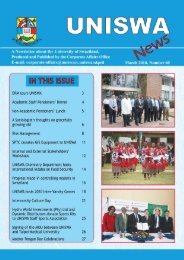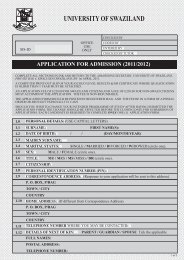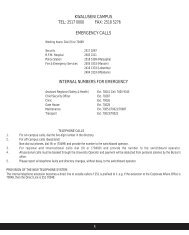UNISWA
October 2013 - University of Swaziland
October 2013 - University of Swaziland
- No tags were found...
You also want an ePaper? Increase the reach of your titles
YUMPU automatically turns print PDFs into web optimized ePapers that Google loves.
There are four types of planted pastures, namelytemporary/emergency forage crop, short term rotationpasture (ley farming), permanent planted pasture andfodder crops. The temporary/emergency forage cropis usually grown over a single growing season, forexample maize for silage or Lucerne for hay. Shortterm rotation pasture (ley farming) is growing crops andpastures in a rotation. The pasture is usually of 3 5 yearsduration and then followed by 2 3 years of crops. Whenthe land is under pasture production, it is said to beresting, and it is time for the land to rebuild its fertilityand soil structure. Permanent planted pasture is plantedand maintained for up to 10 years. When run down,the field is ploughed up and reseeded to a new field ofpasture without incorporating any arable crop. Foddercrops refer to crops grown for livestock production,usually high yielding species of good quality. They areespecially suitable for raising dairy animals in a smallarea of land. They require some form of investmentsuch as high inputs of fertiliser/manure. Some commonfodder species are Napier, forage sorghum, Leucaena andyellow maize. The focus of this article is on permanentand fodder crop types of planted pastures.Growth rates and milk production of animals raisedon natural pastures change greatly during the year.Dairy cows produce more milk during the wet seasonand extremely low milk during the dry season. On theother hand, animals gain weight rapidly during the earlywet season, gain more slowly at the end of the wet andfrequently lose weight during the dry season.The maincause of low productivity is poor quality of feed althoughlow quantity can limit it at the start of the growing season,at high stocking rates and during droughts. Planted(sown) pastures can be highly productive and their useis increasing. They can be used to complement nativepastures and improve the productivity of the wholegrazing enterprise. Sown pastures can help overcomelow productivity by: i. increasing animal productionHarvesting yellow maize for silage makingCows feeding on green chop from yellow maizethrough more and better quality feed, ii. providingmore reliable feed, iii. providing ground cover tomaintain land stability and giving better stock controland reducing cattle handling costs (McIvor et al., 1991;Miller et al., 1991).Provision of more feed and better quality feedPlanted pastures enable stock access to high quality“green” feed throughout the year. Grasses are of lowquality for much of the year because of the stronglyseasonal rainfall and low soil fertility.Legumes on the other hand are of higher quality,especially in old green leaf, dry leaf and stem because ofhigher protein and digestibility levels. This gives betterlive weight gains in summer and a shorter period ofweight loss in winter. In addition, the use of fertilisers,especially N and P, improves pasture quality.Provision of more reliable feedIntroduced species can provide feed when the availabilityor quality of native pastures is low.Many planted grasses stay green until later into the dryseason (winter) and produce green regrowth earlierin spring than native grasses. This helps avoid feedshortages in winter and early spring. The effect of thedeclining maturity of grasses is lessened by legumesor nitrogen-based pastures. Livestock (cattle) can keepgrowing and producing during the early dry season. Theuse of both tropical (summer) and temperate (winter)species is the major way of ensuring reliable feedthroughout the year. Usually the summer species arerainfed while the winter species are irrigated.Many planted species are more nutritious and palatablethan natives. However, there are exceptions. This maybe due to the fact that many planted pasture species16<strong>UNISWA</strong> News - October 2013



